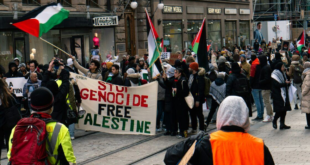TYRE — Nine-year-old Hussein Mahdi writhes in pain on a Beirut hospital bed, trying not to lie on burned parts of his body.
His doctors say the severe burns on his chest, face, hands, legs and back were caused by phosphorous incendiary bombs dropped by the Israelis on civilian areas in southern Lebanon.
“Was my mother also burned?” he cries. But he has not been told that his mother is dead. Hussein is suffering enough pain already. He was rushed to the Beirut hospital from the southern town of Naqura where an Israeli air strike destroyed his home this week, killing his mother and 11-year-old sister.
Mohammad Salam, who leads civil defence rescue workers in the southern port city of Tyre, described a recent operation after another air strike destroyed a house in the nearby village of Bazuriyeh.
First they evacuated a woman and her daughter who were wounded and unconscious. But there was another tiny victim under the debris.
“I found a nine-month-old boy called Yussef Nisr wrapped in blankets in the rubble. I carried him outside towards the ambulance.
And when I unwrapped him his body suddenly turned black from the contact with oxygen.” “He was wounded by phosphorous incendiary bombs,” Salam says.
The Lebanese authorities and rights activists say such cases prove Israel has deployed weapons whose use is strictly regulated in civilian areas. More than 380 civilians have been killed since the offensive began on July 12.
The Israeli military maintains that its forces use their weapons entirely in line with international law. It in turn accuses the Shiite fighters of Hizbollah of packing rockets fired at Israel with ball bearings in order to maximise casualties. A US human rights group said Israel has used cluster bombs in Lebanon, and Lebanese police allege the use not only of phosphorous bombs but also of nail bombs and “bunker busters” on built-up areas.
“Israel must not use indiscriminate weapons,” the New York-based Human Rights Watch (HRW) said.
“Israel has used artillery-fired cluster munitions in populated areas of Lebanon,” charged Kenneth Roth, HRW executive director.
“Cluster munitions are unacceptably inaccurate and unreliable weapons when used around civilians. They should never be used in populated areas,” he added.
A senior Lebanese policeman said the Israelis began using cluster bombs, nail bombs and phosporous incendiary bombs during the second week of their offensive. “They had already used them in the 1978 invasion of Lebanon, attacks in the 1980s and during the 1996 “Grapes of Wrath” military offensive,” he added. A Western weapons expert told AFP: “Cluster munitions are definitely being used by the Israeli army in Lebanon. They are designed to attack armoured vehicles, so it is completely incorrect to use them on civilians.” “We also have reports that phosphorous incendiary bombs are also being used. They are designed to burn, but not to be fired on civilians,” said the expert, declining to be named.
“They are not banned weapons, but under the Geneva conventions they are not allowed to be used against civilians or built-up areas,” he added. An Israeli army spokesman, asked about reports that phosphorous and cluster bombs had been used, said that the military only has “recourse to arms authorised by international law”.
In Tyre, rescue chief Salam described evacuating casualties from the border village of Al Jibbain.
“We were not wearing masks, as our headquarters were bombed a few days ago and we lost a lot of gear. There was an acrid smell, like gas. And every time I stepped on the ground it felt like my shoes were burning. We felt like we were being asphyxiated,” he said.
“We found shells with white smoke coming from them, and a yellow liquid was also leaking from them. It burns the eyes,” Salam added.
Doctor Ibrahim Faraj at the Hiram Hospital in Tyre has treated many of the casualties. “I took shrapnel from the bodies of patients, and it is the first time that I had seen shrapnel disintegrate into small brown pieces,” he said.
 Eurasia Press & News
Eurasia Press & News

